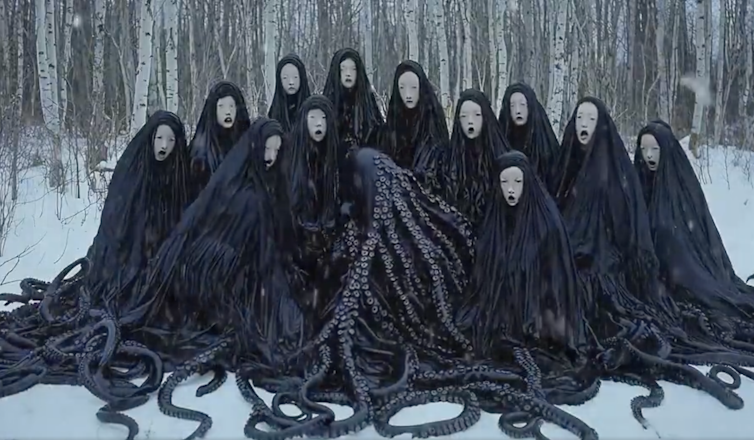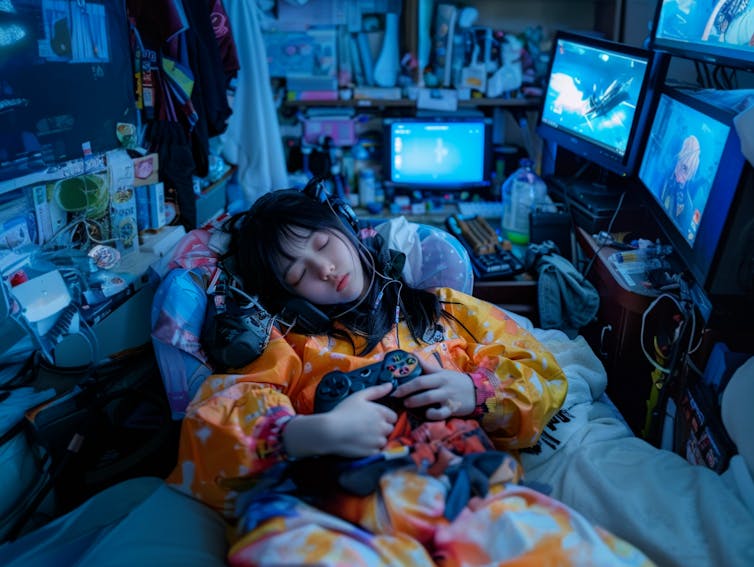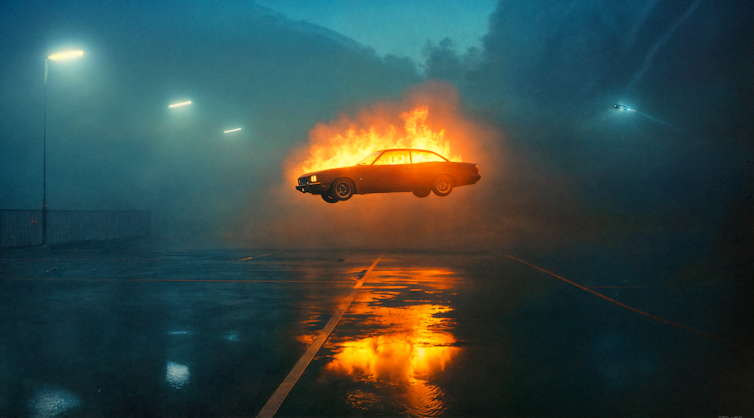
Theo Lindquist
Holly Willis, University of Southern California
Type text into AI image and video generators, and you’ll often see outputs of unusual, sometimes creepy, pictures.
In a way, this is a feature, not a bug, of generative AI. And artists are wielding this aesthetic to create a new storytelling art form.
The tools, such as Midjourney to generate images, Runway and Sora to produce videos, and Luma AI to create 3D objects, are relatively cheap or free to use. They allow filmmakers without access to major studio budgets or soundstages to make imaginative short films for the price of a monthly subscription.
I’ve studied these new works as the co-director of the AI for Media & Storytelling studio at the University of Southern California.
Surveying the increasingly captivating output of artists from around the world, I partnered with curators Jonathan Wells and Meg Grey Wells to produce the Flux Festival, a four-day showcase of experiments in AI filmmaking, in November 2024.
While this work remains dizzyingly eclectic in its stylistic diversity, I would argue that it offers traces of insight into our contemporary world. I’m reminded that in both literary and film studies, scholars believe that as cultures shift, so do the way we tell stories.
With this cultural connection in mind, I see five visual trends emerging in film.
1. Morphing, blurring imagery
In her “NanoFictions” series, the French artist Karoline Georges creates portraits of transformation. In one short, “The Beast,” a burly man mutates from a two-legged human into a hunched, skeletal cat, before morphing into a snarling wolf.
The metaphor – man is a monster – is clear. But what’s more compelling is the thrilling fluidity of transformation. There’s a giddy pleasure in seeing the figure’s seamless evolution that speaks to a very contemporary sensibility of shapeshifting across our many digital selves.

This sense of transformation continues in the use of blurry imagery that, in the hands of some artists, becomes an aesthetic feature rather than a vexing problem.
Theo Lindquist’s “Electronic Dance Experiment #3,” for example, begins as a series of rapid-fire shots showing flashes of nude bodies in a soft smear of pastel colors that pulse and throb. Gradually it becomes clear that this strange fluidity of flesh is a dance. But the abstraction in the blur offers its own unique pleasure; the image can be felt as much as it can be seen.
2. The surreal
Thousands of TikTok videos demonstrate how cringey AI images can get, but artists can wield that weirdness and craft it into something transformative. The Singaporean artist known as Niceaunties creates videos that feature older women and cats, riffing on the concept of the “auntie” from Southeast and East Asian cultures.
In one recent video, the aunties let loose clouds of powerful hairspray to hold up impossible towers of hair in a sequence that grows increasingly ridiculous. Even as they’re playful and poignant, the videos created by Niceaunties can pack a political punch. They comment on assumptions about gender and age, for example, while also tackling contemporary issues such as pollution.
On the darker side, in a music video titled “Forest Never Sleeps,” the artist known as Doopiidoo offers up hybrid octopus-women, guitar-playing rats, rooster-pigs and a wood-chopping ostrich-man. The visual chaos is a sweet match for the accompanying death metal music, with surrealism returning as a powerful form.

Doopiidoo
3. Dark tales
The often-eerie vibe of so much AI-generated imagery works well for chronicling contemporary ills, a fact that several filmmakers use to unexpected effect.
In “La Fenêtre,” Lucas Ortiz Estefanell of the AI agency SpecialGuestX pairs diverse image sequences of people and places with a contemplative voice-over to ponder ideas of reality, privacy and the lives of artificially generated people. At the same time, he wonders about the strong desire to create these synthetic worlds. “When I first watched this video,” recalls the narrator, “the meaning of the image ceased to make sense.”
In the music video titled “Closer,” based on a song by Iceboy Violet and nueen, filmmaker Mau Morgó captures the world-weary exhaustion of Gen Z through dozens of youthful characters slumbering, often under the green glow of video screens. The snapshot of a generation that has come of age in the era of social media and now artificial intelligence, pictured here with phones clutched close to their bodies as they murmur in their sleep, feels quietly wrenching.

Mau Morgó
4. Nostalgia
Sometimes filmmakers turn to AI to capture the past.
Rome-based filmmaker Andrea Ciulu uses AI to reimagine 1980s East Coast hip-hop culture in “On These Streets,” which depicts the city’s expanse and energy through breakdancing as kids run through alleys and then spin magically up into the air.
Ciulu says that he wanted to capture New York’s urban milieu, all of which he experienced at a distance, from Italy, as a kid. The video thus evokes a sense of nostalgia for a mythic time and place to create a memory that is also hallucinatory.

Similarly, David Slade’s “Shadow Rabbit” borrows black-and-white imagery reminiscent of the 1950s to show small children discovering miniature animals crawling about on their hands. In just a few seconds, Slade depicts the enchanting imagination of children and links it to generated imagery, underscoring AI’s capacities for creating fanciful worlds.
5. New times, new spaces
In his video for the song “The Hardest Part” by Washed Out, filmmaker Paul Trillo creates an infinite zoom that follows a group of characters down the seemingly endless aisle of a school bus, through the high school cafeteria and out onto the highway at night. The video perfectly captures the zoominess of time and the collapse of space for someone young and in love haplessly careening through the world.
The freewheeling camera also characterizes the work of Montreal-based duo Vallée Duhamel, whose music video “The Pulse Within” spins and twirls, careening up and around characters who are cut loose from the laws of gravity.
In both music videos, viewers experience time and space as a dazzling, topsy-turvy vortex where the rules of traditional time and space no longer apply.

Source
Right now, in a world where algorithms increasingly shape everyday life, many works of art are beginning to reflect how intertwined we’ve become with computational systems.
What if machines are suggesting new ways to see ourselves, as much as we’re teaching them to see like humans?![]()
Holly Willis, Professor of Cinematic Arts, University of Southern California
This article is republished from The Conversation under a Creative Commons license. Read the original article.

























































